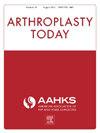Femoral and Patellar Radiographic Metrics Are Improved With Robotic-Assisted Total Knee Arthroplasty
IF 2.1
Q3 ORTHOPEDICS
引用次数: 0
Abstract
Background
Although robotic technology enhanced surgery does not directly address the patella, its associated improvement in knee reconstruction and flexion balance may result in improved patellar function and radiographs. In this retrospective observational analysis, we aimed to 1) compare patellar and femoral radiographic metrics between robotic-assisted and conventional total knee arthroplasty (RA-TKA and C-TKA) and 2) assess the correlation between these radiographic metrics and postoperative patient-reported outcomes in the RA-TKA cohort.
Methods
Fifty RA-TKAs were compared with 50 C-TKAs at an average 2.8 years of follow-up. Age, gender, body mass index, type of arthritis, preoperative range of motion, preoperative pain localization, type of implant, precut patellar thickness at the expected location of the apex, postcut patellar thickness at the same location, patellar button thickness, and length of stay were compared, along with patient reported outcome measures. Descriptive stats, t-tests, chi-squared, and Fisher’s exact tests were applied.
Results
A significantly lower postoperative patellar displacement (1.92 vs 3.16; P = .008) and posterior femoral overstuffing (21.97 vs 23.97; P = .017) were noted among the RA-TKA group. The RA-TKA group had a significantly smaller number of patients with patellar tilt >5 degrees (10% vs 32%; P = .013). The regression analysis of patellar and femoral radiographic metrics revealed no statistically significant correlation between radiographic metrics and majority of patient-reported outcomes within the RA-TKA cohort.
Conclusions
RA-TKA had better patellofemoral metrics than conventional TKA. The RA-TKA group showed a significant improvement in patellar displacement and posterior femoral overstuffing, and lower incidence of patellar tilt >5 degrees compared to the C-TKA cohort.
机器人辅助全膝关节置换术改善了股骨和髌骨影像学指标
虽然机器人技术增强手术不能直接治疗髌骨,但其相关的膝关节重建和屈曲平衡的改善可能导致髌骨功能和x线片的改善。在这项回顾性观察分析中,我们的目的是1)比较机器人辅助和传统全膝关节置换术(RA-TKA和C-TKA)的髌骨和股骨放射学指标,2)评估这些放射学指标与RA-TKA队列中术后患者报告的结果之间的相关性。方法50例ra - tka患者与50例c - tka患者在平均2.8年的随访期间进行比较。比较年龄、性别、体重指数、关节炎类型、术前活动范围、术前疼痛定位、植入物类型、预期尖端位置的切开前髌骨厚度、同一位置的切开后髌骨厚度、髌骨钮扣厚度、住院时间以及患者报告的结果测量。应用了描述性统计、t检验、卡方检验和Fisher精确检验。结果RA-TKA组术后髌骨移位(1.92 vs 3.16, P = 0.008)和股骨后路填充(21.97 vs 23.97, P = 0.017)明显降低。RA-TKA组髌骨倾斜5度的患者数量明显较少(10% vs 32%; P = 0.013)。髌骨和股骨放射学指标的回归分析显示,放射学指标与RA-TKA队列中大多数患者报告的结果之间没有统计学上显著的相关性。结论ra -TKA的髌股指标优于传统TKA。与C-TKA组相比,RA-TKA组髌骨移位和股骨后侧过度填充显著改善,髌骨倾斜发生率降低5度。
本文章由计算机程序翻译,如有差异,请以英文原文为准。
求助全文
约1分钟内获得全文
求助全文
来源期刊

Arthroplasty Today
Medicine-Surgery
CiteScore
2.90
自引率
0.00%
发文量
258
审稿时长
40 weeks
期刊介绍:
Arthroplasty Today is a companion journal to the Journal of Arthroplasty. The journal Arthroplasty Today brings together the clinical and scientific foundations for joint replacement of the hip and knee in an open-access, online format. Arthroplasty Today solicits manuscripts of the highest quality from all areas of scientific endeavor that relate to joint replacement or the treatment of its complications, including those dealing with patient outcomes, economic and policy issues, prosthetic design, biomechanics, biomaterials, and biologic response to arthroplasty. The journal focuses on case reports. It is the purpose of Arthroplasty Today to present material to practicing orthopaedic surgeons that will keep them abreast of developments in the field, prove useful in the care of patients, and aid in understanding the scientific foundation of this subspecialty area of joint replacement. The international members of the Editorial Board provide a worldwide perspective for the journal''s area of interest. Their participation ensures that each issue of Arthroplasty Today provides the reader with timely, peer-reviewed articles of the highest quality.
 求助内容:
求助内容: 应助结果提醒方式:
应助结果提醒方式:


